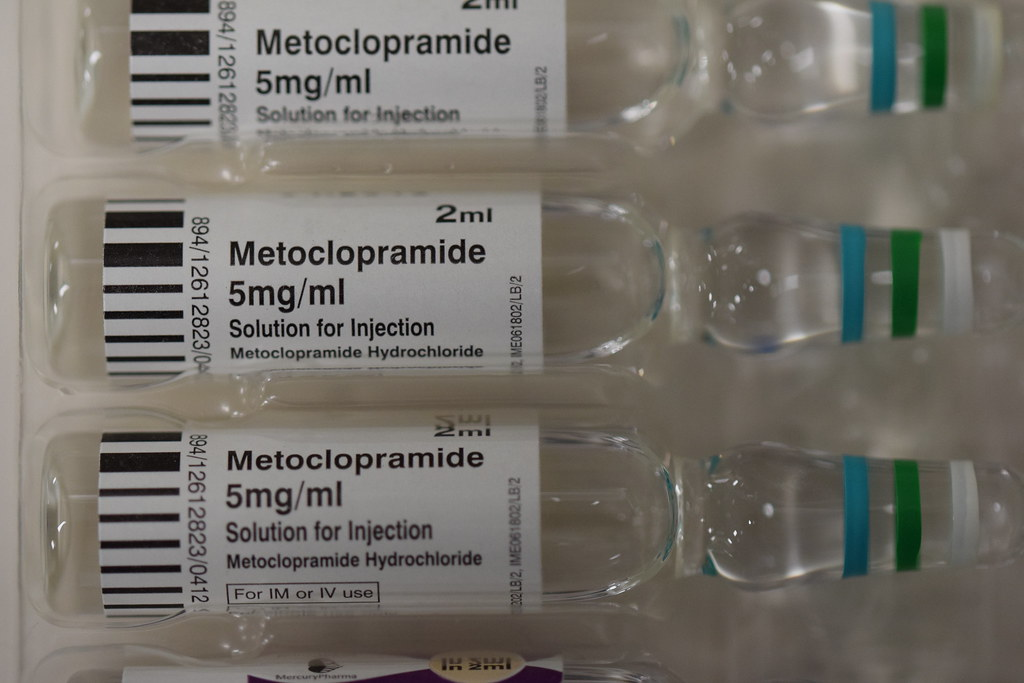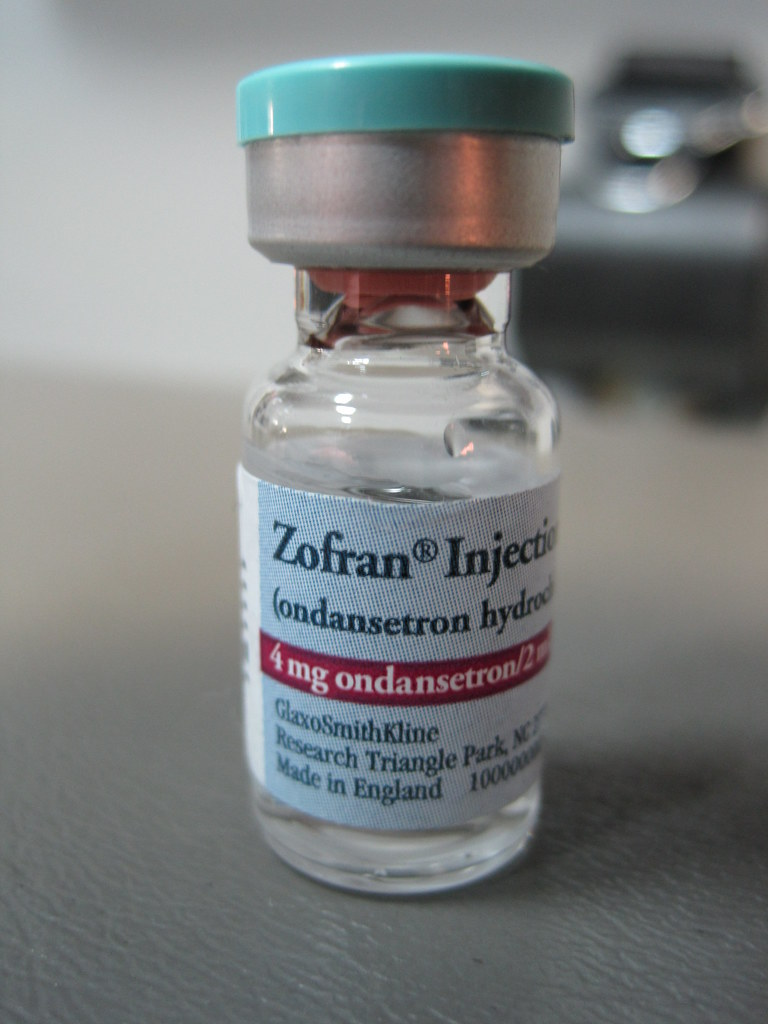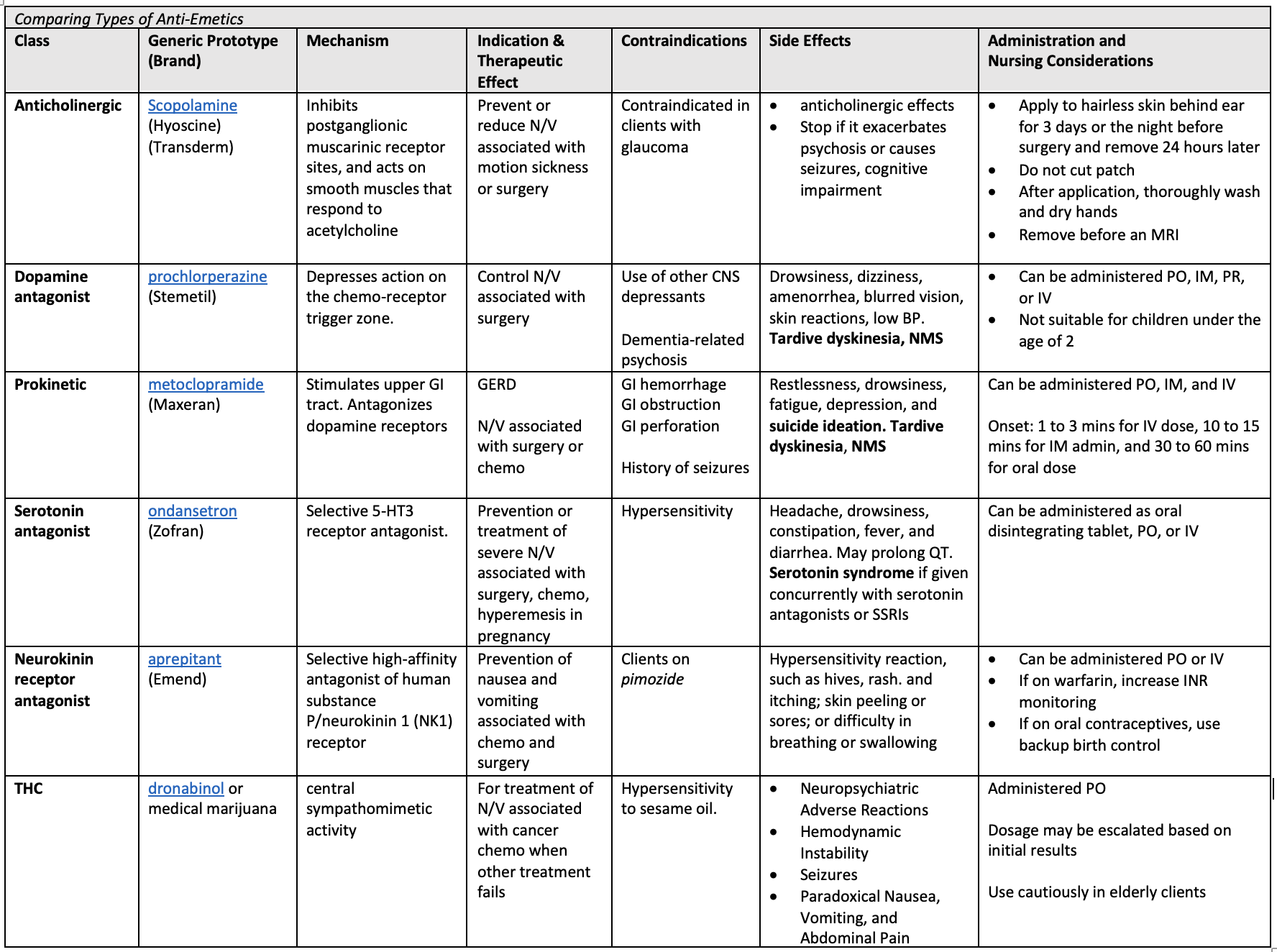Gastrointestinal Elimination
7.7 Antiemetics
Open Resources for Nursing (Open RN)
Treatment of nausea and vomiting should be tailored to the cause. There are several medications that work on different neuroreceptors that, when used, can treat nausea and vomiting. For severe cases of vomiting, intravenous fluids may also be needed to treat the accompanying dehydration. [1],[2]
Table 7.7a compares the neurotransmitters involved in the nausea and vomiting process, classes of antiemetic medication targeting these neurotransmitters, prototype antiemetic medications, and associated mechanisms of action.[3] [4][5][6] Each medication class is also discussed in more detail later in this section.
Table 7.7a Neurotransmitters and Associated Medications Used to Treat Nausea and Vomiting
| Neurotransmitter | Medication |
Antiemetic Drug | Mechanism of Action |
|---|---|---|---|
| Acetylcholine (M1) | Anticholinergics | scopolamine | Blocks ACh receptors in vestibular system |
| Histamine (H1) | Antihistamines | meclizine | Blocks H1 receptors and thus blocks ACh in vestibular system |
| Dopamine (DA2) | Dopamine antagonists | prochlorperazine | Blocks dopamine in CTZ and may block ACh |
| Dopamine and ACh (DA2 and M1) | Prokinetics | metoclopramide | Blocks dopamine in CTZ and stimulates ACh in GI tract |
| Serotonin (5HT) | Serotonin antagonists | ondansetron | Blocks serotonin in GI tract, CTZ, and VC |
| Substance P (NK1) | Neurokinin antagonists | aprepitant | Inhibits substance P neurokinin receptors |
| Cannabinoid (CB1) | Tetrahydrocannabinols (THC) | dronabinol or medical marijuana | Activated CB1 receptor leading to inhibitory effects on cerebral cortex |
Anticholinergics
Scopolamine is an example of an anticholinergic medication that is often used to treat motion sickness or nausea and vomiting associated with surgical recovery from anesthesia and/or opiate analgesia.
Mechanism of Action
Anticholinergics block ACh receptors in the vestibular center and within the brain to prevent nausea-inducing stimuli to the Chemoreceptor Trigger Zone (CTZ) and the Vomiting Center (VC). They also dry GI secretions and reduce smooth muscle spasms.
Specific Administration Considerations
The scopolamine transdermal patch (see Figure 7.7a)[7] is designed for continuous release of scopolamine following the application to an area of intact skin on the head, behind the ear. The system is formulated to deliver approximately 1 mg of scopolamine to the systemic circulation over 3 days. It is contraindicated in clients with glaucoma. It has been reported to exacerbate psychosis, induce seizures, and cause drowsiness, confusion, and sedation. Due to its anticholinergic properties, scopolamine can decrease gastrointestinal motility and cause urinary retention. Nurses should perform more frequent monitoring during treatment with Transderm Scōp and discontinue Transderm Scōp in clients who develop difficulty in urination. Transderm Scōp contains an aluminized membrane; skin burns have been reported at the application site in clients wearing an aluminized transdermal system during an MRI scan. Remove Transderm Scōp before undergoing an MRI.

Application instructions:
- Only wear one transdermal system at any time.
- Do not cut the transdermal system.
- Apply the transdermal system to the skin in the postauricular area (hairless area behind one ear).
- After the transdermal system is applied on the dry skin behind the ear, wash hands thoroughly with soap and water and dry hands.
- If the transdermal system becomes displaced, discard the transdermal system, and apply a new transdermal system on the hairless area behind the other ear.
- For surgeries other than cesarean section, apply one Transderm Scōp transdermal system the evening before a scheduled surgery. Remove the transdermal system 24 hours following surgery.
Patient Teaching & Education
Transderm Scōp may impair the mental and/or physical abilities required for the performance of hazardous tasks such as driving a motor vehicle, operating machinery, or participating in underwater sports. Concomitant use of other drugs (e.g., alcohol, sedatives, hypnotics, opiates, and anxiolytics) that cause central nervous system (CNS) adverse reactions, or that have anticholinergic properties, may increase this impairment. Inform clients not to operate motor vehicles or other dangerous machinery or participate in underwater sports until they are reasonably certain that Transderm Scōp does not affect them adversely. Scopolamine can cause temporary dilation of the pupils resulting in blurred vision if it comes in contact with the eyes. Advise clients to wash their hands thoroughly with soap and water and dry their hands immediately after handling the transdermal system. Upon removal, fold the used transdermal system in half with the sticky side together, and discard in household trash in a manner that prevents accidental contact or ingestion by children, pets, or others.[8]
Antihistamines
Meclizine is an example of an antihistamine that is often used to treat motion sickness.
Mechanism of Action
Antihistamines block H1 receptors in the vestibular center and may also block acetylcholine (ACh).
Specific Administration Considerations
Antihistamines are contraindicated in clients with glaucoma or an enlarged prostate gland. Dosage should be started one hour before travel begins.
Patient Teaching & Education
- Do not exceed recommended dosage.
- Be advised that drowsiness may occur.
- Avoid alcohol, sedatives, and tranquilizers, which may increase drowsiness.
- Avoid alcoholic drinks.
- Be careful when driving a motor vehicle or operating machinery.[9]
Dopamine Antagonists
Prochlorperazine is an example of a dopamine antagonist used to treat nausea and vomiting. It can also be used as an antipsychotic medication.
Mechanism of Action
Prochlorperazine blocks dopamine in the Chemoreceptor Trigger Zone (CTZ). It also calms the central nervous system and may also block acetylcholine.
Specific Administration Considerations
Prochlorperazine can be administered orally, intramuscularly, rectally or intravenously. It is contraindicated in children under age 2 or under 20 pounds. Severe side effects have occurred when used to treat psychosis.
Patient Teaching & Education
Clients should be instructed to take medications as prescribed. They should avoid alcohol and other CNS depressants. Clients may experience increased photosensitivity and extreme temperatures should be avoided. Clients should be advised that urine may turn pinkish to reddish-brown.[10]
Prokinetics
Metoclopramide is an example of a prokinetic medication (see Figure 7.7b).[11]

Mechanism of Action
Metoclopramide blocks dopamine and may also sensitize tissues to acetylcholine. It is used to promote peristalsis to empty the gastrointestinal tract and thus reduce nausea.
Specific Administration Considerations
Metoclopramide can be administered orally, intramuscularly, and intravenously. The onset of pharmacological action of metoclopramide is 1 to 3 minutes following an intravenous dose, 10 to 15 minutes following intramuscular administration, and 30 to 60 minutes following an oral dose. Pharmacological effects persist for 1 to 2 hours.
Metoclopramide should not be used whenever stimulation of gastrointestinal motility might be dangerous (e.g., in the presence of gastrointestinal hemorrhage, mechanical obstruction, or perforation). Metoclopramide is contraindicated in clients with pheochromocytoma because the drug may cause a hypertensive crisis. Metoclopramide should not be used in epileptics or clients receiving other drugs that are likely to cause extrapyramidal reactions because the frequency and severity of seizures or extrapyramidal reactions may be increased. Rare reports of neuromalignant syndrome have occurred.
Patient Teaching & Education
Teach clients to immediately inform the healthcare provider if they experience new feelings of depression or abnormal muscle movements they cannot control such as:
- lip-smacking, chewing, or puckering of the mouth
- frowning or scowling
- sticking out the tongue
- blinking and moving the eyes
- shaking of the arms and legs[12]
Serotonin Antagonists
Ondansetron is an example of a serotonin (5HT) antagonist often used to treat severe nausea and vomiting associated with chemotherapy, postoperative nausea and vomiting, and hyperemesis during pregnancy. (See Figure 7.7c for an image of odansetron blocking the 5-HT3 receptor.[13])

Mechanism of Action
Ondansetron blocks serotonin receptors in the GI tract, the chemoreceptor trigger zone (CTZ), and the vomiting center (VC). See Figures 7.7d and 7.7e for images of the injectable and oral formulations of ondansetron.[14],[15]


Specific Administration Considerations
Ondansetron is available as an orally disintegrating tablet and as an injectable for those clients too nauseated to tolerate oral medication. It is contraindicated with apomorphine. Serotonin syndrome can occur if administered concurrently with other serotonin antagonists or selective serotonin reuptake inhibitors. Ondansetron can cause headaches, drowsiness, constipation, fever, and diarrhea. A rare but serious adverse effect of ondansetron is QT prolongation that can cause an abnormal cardiac rhythm.
Patient Teaching & Education
Teach clients to immediately inform their healthcare provider if they experience a change in heart rate, lightheadedness, or feel faint or have any signs and symptoms of hypersensitivity reactions such as fever, chills, rash, or breathing problems.[16]
Neurokinin Receptor Antagonists
Aprepitant is an example of a neurokinin antagonist used to prevent nausea and vomiting associated with chemotherapy and surgery.
Mechanism of Action
Aprepitant inhibits substance-P neurokinin receptors in the brainstem.
Nursing Considerations
Aprepitant is usually administered concurrently with dexamethasone (a corticosteroid) and ondansetron. It can be administered orally or intravenously. It has clinically significant CYP3A4 drug interactions with medications such as pimozide, diltiazem, and rifampin, and can decrease INR levels when taken concurrently with warfarin. It can also reduce the effectiveness of oral contraceptives.
Patient Teaching & Education
Teach clients taking warfarin that they will need to monitor their INR levels more closely, which may require adjustment of the warfarin dosage while taking aprepitant. Teach clients using an oral contraceptive to use backup birth control.[17]
Tetrahydrocannabinoids (THC)
Dronabinol or medical marijuana is an example of a THC medication used to treat nausea in clients with cancer or AIDS (see Figures 7.7f and 7.7g).[18]


Mechanism of Action
THC has inhibitory effects in the cerebral cortex causing an alteration in mood and the body’s perception of its surroundings, which may relieve nausea and vomiting, as well as stimulate the appetite.
Specific Administration Considerations
THC will cause a dose-related “high” (easy laughing, elation, and heightened awareness). It is abusable and, thus, is a controlled substance and scheduled medication. THC should be used cautiously in elderly clients because they may be more sensitive to the neurological, psychoactive, and postural hypotensive effects of the drug. In general, dose selection for an elderly client should be cautious, usually starting at the low end of the dosing range.
Patient Teaching & Education
Clients should not drive, operate machinery, or engage in any hazardous activity when using THC. Keep out of reach of children and pets.[19]
Herbal and Vitamin Supplements
Ginger has been used in traditional Indian and Chinese medicine as an antiemetic. Although its mechanism of action is not completely understood, ginger is thought to antagonize the 5HT and cholinergic receptors and may have direct effect on the gastrointestinal tract. Although ginger can cause reflux and heartburn and may potentially cause bleeding because of its anticoagulant effects, dosages of up to 2 g per day in divided doses of 250 mg are considered safe, even in pregnant women. Pyridoxine (vitamin B6) has also been recommended for treating nausea and vomiting in pregnancy. Typical dosages of pyridoxine, 10 to 25 mg every eight hours, cause minimal adverse effects. [20]
Antiemetics Medication Grid
Now let’s take a closer look at the medication grids comparing medications used to treat nausea and vomiting, in Table 7.7a [21].
Medication cards like this are intended to assist students to learn key points about each medication. Because information about medication is constantly changing, nurses should always consult evidence-based resources to review current recommendations before administering specific medication. Basic information related to each class of medication is outlined below. Prototype or generic medication examples are also hyperlinked to a free resource at Daily Med. On the home page, enter the drug name in the search bar to read more about the medication.
Table 7.7 Comparing Medications Used to Treat Nausea and Vomiting [22][23][24][25] scopolamine , meclizine, prochlorperazine, metoclopramide, ondansetron, aprepitant, dronabinol or medical marijuana

Clinical Reasoning and Decision-Making Activity 7.7
A nurse is caring for a client who underwent surgery earlier today and is experiencing nausea and vomiting. The original post-op orders included prochlorperazine, but the client continues to experience vomiting despite receiving this medication. The nurse calls the provider and receives a new order for ondansetron orally dissolving tablets, 8 mg three times daily as needed.
- How will the nurse assess for symptoms of dehydration?
- When administering the medication, the client states, “This tastes terrible! Why can’t I have a normal pill to swallow?” What is the nurse’s best response?
- What other measures should the nurse teach the clients to reduce feelings of nausea and avoid dehydration?
Note: Answers to the Critical Thinking activities can be found in the “Answer Key” sections at the end of the book.
Media Attributions
- Comparing Type of Anti-emetics
- MedlinePlus [Internet]. Bethesda (MD): National Library of Medicine (US); [updated 2019 October 23]. Nausea and vomiting; [updated 2019 February 7; reviewed 2016 March 17; cited 2019 October 27]. https://medlineplus.gov/nauseaandvomiting.html. ↵
- Bashashati, M. & McCallum, R. (2014). Neurochemical mechanisms and pharmacologic strategies in managing nausea and vomiting related to cyclic vomiting syndrome and other gastrointestinal disorders. European Journal of Pharmacology, 772, p 79. ↵
- Bashashati, M. and McCallum, R. (2014). Neurochemical mechanisms and pharmacologic strategies in managing nausea and vomiting related to cyclic vomiting syndrome and other gastrointestinal disorders. European Journal of Pharmacology, 772, p 79. ↵
- RNPedia. (2021). https://www.rnpedia.com ↵
- OpenMD.Com at openmd.com ↵
- uCentral from Unbound Medicine. https://www.unboundmedicine.com/ucentral ↵
- "Scopoderm 278:365" by Andreas Nilsson is licensed under CC BY-NC-ND 2.0 ↵
- This work is a derivative of Daily Med by U.S. National Library of Medicine in the public domain. ↵
- This work is a derivative of Daily Med by U.S. National Library of Medicine in the public domain. ↵
- uCentral from Unbound Medicine. https://www.unboundmedicine.com/ucentral ↵
- "Metoclopramide" by John Campbell is licensed under CC0 ↵
- This work is a derivative of Daily Med by U.S. National Library of Medicine in the public domain. ↵
- "Eichelbaum2.jpg" by Michel Eichelbaum is licensed under CC BY-SA 3.0 DE ↵
- "000817lg Zofran 8 MG Oral Tablet.jpg" by NLM is licensed under CC0 ↵
- "Ondansetron (1)" by M is licensed under CC BY-NC 2.0 ↵
- This work is a derivative of Daily Med by U.S. National Library of Medicine in the public domain. ↵
- This work is a derivative of Daily Med by U.S. National Library of Medicine in the public domain. ↵
- "Marinol - Dronabinol" by Steffen Geyer is licensed under CC BY-NC 2.0 & 7.21"Medical Marijuana" by Circe Denyer is licensed under CC0 ↵
- This work is a derivative of Daily Med by U.S. National Library of Medicine in the public domain. ↵
- Flake, Z., Linn, B., & Hornecker, J. (2015). Practical selection of antiemetics in the ambulatory setting. American Family Physician, 91(5): pp 293-296. ↵
- This work is a derivative of Daily Med by U.S. National Library of Medicine in the public domain. ↵
- This work is a derivative of Daily Med by U.S. National Library of Medicine in the public domain. ↵
- RNPedia. (2021). https://www.rnpedia.com ↵
- OpenMD.Com at openmd.com ↵
- uCentral from Unbound Medicine. https://www.unboundmedicine.com/ucentral ↵
Medications used to promote peristalsis to empty the gastrointestinal tract and reduce nausea.
Symptoms associated with serotonin syndrome may include the following combination of signs and symptoms: mental status changes (e.g., agitation, hallucinations, delirium, and coma), autonomic instability (e.g., tachycardia, labile blood pressure, dizziness, diaphoresis, flushing, hyperthermia), neuromuscular symptoms (e.g., tremor, rigidity, myoclonus, hyperreflexia, incoordination), seizures, with or without gastrointestinal symptoms (e.g., nausea, vomiting, diarrhea).
Tetrahydrocannabinoids found in marijuana.

